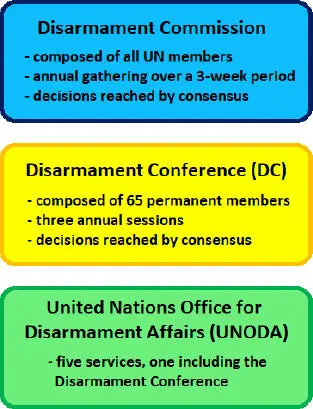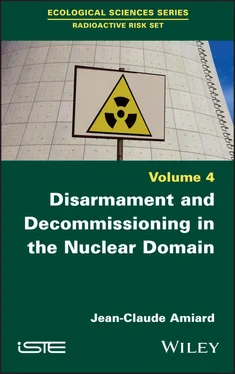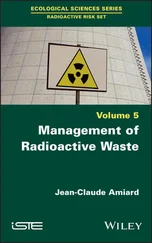1.2. The first countries to acquire the atomic bomb
Five states have carried out their first atomic tests: the United States on July 16, 1945, the Soviet Union on August 29, 1949, the United Kingdom on October 3, 1952, France on February 13, 1960 and China on October 16, 1964.
In order to prevent the number of states possessing nuclear weapons from becoming too large, the United Nations has been concerned with nuclear disarmament from the outset, and four UN structures are particularly responsible for this task: the Security Council, the Disarmament Commission, the Conference on Disarmament and the Office for Disarmament Affairs [GIL 18].
The Security Council has primary responsibility under the UN Charter for the maintenance of international peace and security. It is composed of five permanent members (China, France, the Russian Federation, the United Kingdom and the United States) and 10 non-permanent members elected by the General Assembly for a period of two years. The general organization of the UN is shown in Figure 1.1.
The United Nations Disarmament Commission (UNDC) was established in 1952, within the framework of the Security Council, by General Assembly Resolution 502 (VI), to deal with disarmament issues. However, it only met occasionally after 1959. In 1978, the first special session of the General Assembly devoted to disarmament established a new Disarmament Commission as a subsidiary organ of the Assembly, composed of all UN member states of the Organization. It was established as a deliberative body to consider various disarmament issues and monitor the implementation of the relevant decisions and recommendations adopted at the special session. It sits in New York for three weeks each year (usually in early spring). It considers a limited number of agenda items on a three-year cycle and submits an annual report to the General Assembly [GIL 18].

Figure 1.1. The United Nations organization. For a color version of this figure, see www.iste.co.uk/amiard/disarmament.zip
The Conference on Disarmament is the only multilateral forum for negotiating disarmament agreements. It is composed of 65 permanent members who hold three sessions a year in Geneva (usually January to March, May to June and August to September). It operates on the basis of consensus to ensure full support for the agreements reached. It has completed negotiations on the Comprehensive Nuclear-Test-Ban Treaty, but has not yet entered into force [GIL 18].
The Office for Disarmament Affairs, established in 1982, works to promote disarmament and non-proliferation and to strengthen disarmament regimes. Part of its work focuses on nuclear weapons [GIL 18] ( Figure 1.2).
The first treaty limiting the use of weapons (particularly nuclear weapons), the Antarctic Treaty, signed in Washington, entered into force on June 23, 1961. This treaty stipulates that the Antarctic is an area exclusively reserved for peaceful purposes and prohibits all activities of a military nature, such as military maneuvers and the testing of any kind of weapon.

Figure 1.2. The various UN bodies working on non-proliferation and disarmament. UNODA: United Nations Office for Disarmament Affairs. For a color version of this figure, see www.iste.co.uk/amiard/disarmament.zip
The International Treaty on the Non-Proliferation of Nuclear Weapons (NPT) was developed within the UN by the Eighteen-Power Committee on Disarmament. Concrete negotiations lasted three years, from 1965 to 1968. The text was mainly drawn up by the United States and the Soviet Union. On July 1, 1968, the treaty was opened for signature in Moscow, Washington and London. It entered into force on March 5, 1970 after ratification by the three depositary Powers and 40 other signatory states [AIE 70].
For the treaty itself, the parties had to decide on its extension 25 years after its entry into force. Despite the reluctance of some non-aligned countries (Mexico and Indonesia) and Arab countries (because of Israel’s absence from the treaty), the NPT was extended indefinitely on May 11, 1995 [IRS 19a].
The NPT is now close to universality, with 191 states as members. Only four states have not joined: India, Israel, Pakistan and Southern Sudan. However, in January 2003, North Korea initiated a procedure to withdraw from the treaty [FRA 19b].
1.3.1. The functioning of the Treaty
In the operation of the NPT, states are divided into two categories. The first category consists of the nuclear-weapon states (NWS). These are the five official nuclear powers (United States, Russia, United Kingdom, France, China), which according to Article IX “ had manufactured and detonated a nuclear explosive device prior to 1 January 1967 ” and are entitled to possess such weapons. The second category includes all non-nuclear weapon states (NNWS), which make up the rest of the NPT membership. For the purpose of control or safeguarding, this last category is divided into two sub-categories depending on whether or not the states have access to nuclear facilities (see section 4.1.1).
For many years, this NPT has not been functioning well. This is mainly due to non-compliance with two clauses. The first clause is the non-implementation of a process to create a zone free of nuclear weapons and weapons of mass destruction in the Middle East. The second clause is related to the hypocrisy of the five weapon states, who do not respect the spirit and letter of the NPT. Indeed, while no one can deny that the nuclear arsenals of these states, with the exception of China, have indeed decreased since the Cold War, it must also be noted that all of these states have undertaken processes of modernizing nuclear weapons and delivery systems.
This treaty seems to have reached its maximum effectiveness with regard to the two pillars of non-proliferation and the peaceful use of nuclear energy, but it seems limited in effectively forcing the NWS to implement the third pillar, that of a real disarmament policy [COL 15].
1.3.2. Revision of the NPT
This treaty is subject to a Review Conference (RevCom) every five years: the next one was due to take place in 2020, interspersed with three so-called Preparatory Conferences (PrepCom). The RevCom is an opportunity to take stock of the progress made in the past and the future of the treaty in a roadmap, which is called the Final Document [COL 15].
1.3.3. Successes of the NPT
The main success of the treaty is South Africa’s renunciation of nuclear weapons. The first, and only South African nuclear research reactor is the SAFARI-1 (South African Fundamental Atomic Research Installation 1), built between 1961 and 1965 on the Pelindaba site. This site also housed a reprocessing plant (Plant Y). The country also had a secret military program for the South African Defence Force, abandoned by the ratification of the Treaty on the Non-Proliferation of Nuclear Weapons before the African National Congress came to power. The six aerial atomic bombs with a power of 15 to 20 kt, built between 1982 and 1989, and a seventh, which was under construction, were dismantled before 1993 [TOU 13].
Historically, the AEC (Atomic Energy Corporation) had two sites – Valindaba, for the production of highly enriched uranium (HEU) and Pelindaba, for research. The ARMSCOR (Armaments Corporation of South Africa) depended on the Ministry of Defense with two sites – Kentron and Naschem. The production of highly enriched uranium by the South African enrichment plant Y in 1994 was 993 kg (enriched on average to 68% in 235U), of which 515 kg were enriched to 85% in 235U [ALB 16].
Читать дальше













